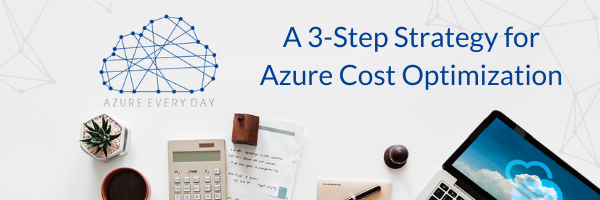A 3-Step Strategy for Azure Cost Optimization


Monitoring and controlling cloud costs is a top priority for businesses. There are three important steps involved in a cost optimization strategy.
Step One - Define – Processes to Manage Cost
- When preparing to migrate to the cloud, it’s crucial that you implement governance policies for effective enterprise cloud management. Cost optimization should be a well-defined strategy supported by your cloud governance policy. Your policies should include:
- Define the process for resource provisioning.
- Identify people in your organization that will have the ability to deploy resources, as well as someone responsible for managing workloads in Azure.
- Define the processes of budgeting, cost allocation, and charge back.
- Administer an asset tagging policy that will help you with chargebacks and cost allocation. Mandate that each asset in your Azure platform needs to be tagged with the project, department, or application it’s associated with.
- Your policy should also mandate the use of metrics to estimate and forecast overall cost.
Step Two – Control – Azure Cost Reducing Tools
- Select the Azure tools you’ll use to take charge of your organization’s Azure spending. There are many tools/resources available; a few are highlighted below:
- Azure Advisor – This is a service that identifies virtual machines with low utilization, formative CPU, or network usage standpoint. Based on the Advisor’s estimate, you can decide to shut down or resize the machine. It also gives you recommendations for cost savings.
- Azure Dev/Test Pricing – Azure offers a discount for dev and test resources; you can save up to 55% on non-production resources.
- Storage Tiering – Azure Blob Storage pricing provides premium hot, cool and archive storage tiers with several redundancy options. Make sure you know all the options to ensure the best choice for your project.
- Right-Sizing VMs and Enabling Auto Scaling – Azure provides a wide range of VMs with different hardware and performance capabilities. Only when all your VMs are utilized at 100% will you achieve optimal costs. Try different VM options to find the one best suited to your project where VMs can be utilized close to 100%.
- Moving from Database VMs to Elastic Databases – Consider moving any databases on VMs to a PaaS model. In most cases, moving to Azure SQL Service will result in significant cost reductions.
Step Three – Monitor – Azure Cost Management
- The final step is to monitor. As mandated in the cloud governance policy discussed in step one, it’s important that you use metrics and insights to look for any adjustments needed in your Azure environment. Monitoring allows you to budget, forecast and do cost analysis.
- Azure Cost Management is a free service that helps visualize and forecast costs, as well as identify anomalies and find optimization opportunities.
- Cost analysis can be used for budgeting and forecasting to proactively manage costs and drive accountability within your organization.
- Azure Consumption Insight is a connector for Azure Cost Management in Power BI. Use this to get more in-depth data analysis and to create custom reports and measures to better understand and analyze your Azure span.
These are just a few of the tools and options available to optimize your Azure costs. It’s important to have a cost optimization strategy and if you follow these three steps, you can effectively control cloud costs.
If you want to learn more about cloud cost optimization or about Azure in general, you’re in the right place. Our cloud and Azure experts are here to help you no matter where you are on your cloud journey. Click below to learn more about our Remote Services offerings.
Sign-up now and get instant access

Free Community Plan
On-demand learning
Most Recent
private training






-1.png)
Leave a comment